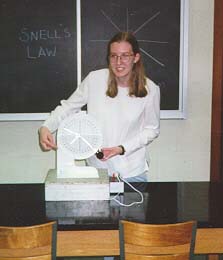Demonstration goals:
- Demonstrate Snell’s Law
- Show that the the coefficients of reflection and transmission depend on incidence angle
One of our most important methods for learning about the Earth’s interior is the study of seismic waves; energy that travels through the Earth in the form of sound. The existence of the Mohorovicic layer, the liquid outer core of the Earth and the solid inner core were all deduced from sound waves that had traveled through the Earth, interacting with the layers. Because of the way that seismic energy propagates through the Earth, we know that the entire interior, with the sole exception of the outer core, is solid.
In mineralogy, the way that light is transmitted through a crystal is a diagnostic tool. By measuring the refractive index (the way the light bends as it moves from mineral to another) and the motion of Becke lines, a mineralogist can determine the difference between crystals of quartz and calcite. But how are these differences detected? And what causes them?
When a wave of energy comes to a place where two layers meet (called an interface), the energy can go two directions. If the energy bounces off of the interface and stays in the first medium, then it is said to be reflected. If the energy goes through the interface into the second medium, then it is said to be transmitted. The exact relationship between the angle the incoming ray makes (the angle of incidence) and the angles that the reflected and transmitted rays make (the angles of reflection and transmission, respectively) was discovered by Willebrord Snell. His law is:
Definitions: The angle of incidence (iinc) is the angle the incoming ray makes with respect to the normal to the interface. The angle of reflection (irfl) is the angle the reflected ray makes with respect to the normal to the interface. The angle of transmission (itrn) is the angle the ray in the second material makes with respect to the normal to the interface. All angles are measured with respect to the normal to the interface!
The velocity of the reflected wave (Vrfl) is equal to the velocity of the incident wave (Vinc), since they travel in the same medium. Thus, we arrive at the often stated “the angle of reflection is equal to the angle of incidence”. But how does iinc relate to itrn? From Snell’s Law, we can see that increasing the velocity of the transmitted wave (Vtrn) means that itrn must also increase. (Since the ratio is a constant.) Thus, if the second medium is faster than the first, the wave will turn away from the normal and toward the horizontal.
Snell applied his work only to the laws of geometric optics, and did not publish his results; as a result, the importance of his work was not known until Huygens published Dioptrica in 1703. Until then, many scientists used the (incorrect) formulation of Kepler. In 1658, Fermat showed that Snell’s law was applicable to any wave traveling through any medium, whether it was light in water or sound in the Earth.
To perform this demonstration, you will need:
Snell’s Law Tank
This experiment works best in a dim room.
1. Write Snell’s Law on the board. Plug in the light source (or turn on the flashlight). Starting from vertical incidence (i = 0o), slowly move the light source and note how the angles of reflection and transmission change.
2. Continue moving the light source until all of the light is trapped within the water; this is the angle of critical reflection. You may want to move the light source about this angle to show how the reflected beam grows brighter and the transmitted beam dims.
For more advanced classes:
3. Pour a thin layer of cooking oil, such as canola or safflower, on top of the water. Repeat the experiment, and note how the ray bends at both the water-oil and the oil-air interfaces. Try increasing the thickness of the oil layer. If you have enough time (and skill), you may want to try adding a layer of rubbing alcohol on top of the oil.
4. Drill a small hole in the cap of a plastic 2-l pop bottle, and another in the side. Place tape over the hole in the side, and fill the bottle with water. Dim the lights and place the bottle over a large bowl or basin. Place a flashlight at the bottom of the pop bottle, so that it shines onto the cap. Remove the tape from the hole, so that the water flows out of the cap (you may need to tilt the bottle slightly. Point out the bright spot in the stream of water coming from the cap; this is light, caught inside the water by total internal reflection.
For Discussion:
In which layer was the speed of light the fastest? How do you know?
